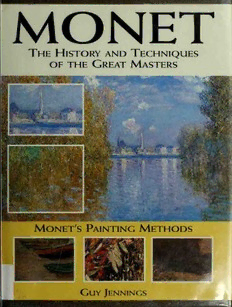
Monet PDF
Preview Monet
MONET The History and Techniques of the Great Masters Monet's Painting Methods Guy Jennings MONET Anyonewho hasvisited anartgallerywill understand thevalueofbeingableto lookat paintingsclose up, toseetheway thecolors have been used and howthe paint has been handled. Nowyou can haveyourown personal artgallery in thisseriesofbooks, The HistoryandTechniquesoftheGreatMasters. Each book bringsyouaselection often or morefamous paintings, magnificently reproduced in full color, and with actual size detailssothatyou can see thewaytheartist hasworked-justasthough the paintings were hangingonyourown walls. Thetext analyzeseach painting in turn, and informativecaptionstellyou exactlywhich techniquestheartist has used toobtain particulareffects, whattypeofcanvasand primingwas used, and howthecolorswere chosen, mixed and applied. Claude Monetwasthecentral figure in the Impressionistmovement, onewhichwasto transform paintingall overtheworld and to win alasting popularityfor itsexponents. The Impressionists brokeawayfrom theaccepted c^S historical, religiousand mythological subject- matterand painted whattheysawaround them-landscapesand scenesofeveryday life. Monethimselfwentfurther, always C-3 workingoutofdoorsdirectly from life. He rejected thesmooth brushworkfavored bythe Academiciansoftheday, handling hispaintin avaried and inventiveway sothatthe texturesfound in natureareemulated by the marksofhis brush. His lifeasan artistwasan unceasingstruggleto record the fleeting effectsofnature by meansofasmall palette ofpure, brightcolors, and heoften painted CO several versionsofthesameview under different lights, workingon fourorfive paintings in thecourseofoneday. Theselection ofpaintings shown here records thesuccessofhisstruggle, and traces his developmentfrom earlyworkssuchas Women in theGarden, through the "series" paintingstothe last, great Waterliliespanels, painted forthe French nation. In thetext, the authoroutlinesthe majorevents in Monet's lifeand explainsthe ideas behind hiswork. The History and Techniques of The Great Masters Monet i The History and Techniques of The Great Masters Monet Trewin Copplestone CHARTWELL BOOKS. INC A QUANTUM BOOK Published byChartwellBooks ADivisionofBookSalesInc 114NorthfieldAvenue Edison,NewJersey08837 USA Copyright© 1987QuartoPublishingpic Thisedition printed 1997 Allrightsreserved. Thisbookisprotectedbycopyright.Nopartofitmaybe reproduced,stored inaretrievalsystem,ortransmittedinany formorbyanymeans,withoutthepriorpermissioninwriting ofthePublisher,norbeotherwisecirculatedinanyformof bindingorcoverotherthan thatinwhichitispublishedand withoutasimilarcondition includingthisconditionbeing imposedonthesubsequentpublisher. ISBN0-7858-0794-2 QUM2MON Thisbookwasproduced by QuantumBooksLtd 6BlundellStreet LondonN79BH Printed inChinabyLeefung-AscoPrintersLtd SeniorEditorPolly Powell ArtEditorVincent Murphy Project Editor Hazel Harrison DesignerTerrySmith PictureResearcherCelestineDars Art DirectorMoiraClinch Editorial DirectorCarolyn King ManythankstoBohCockerandPaulSwain TypesetbyQVTypesettingLtd Manufacturedin HongKongbyRegent BR BR PublishingServicesLimited ND553 .M7 C66 1997bx Contents Introduction -6- Chronology - 16- The Paintings Women in the Garden 18 Bathing at La Grenouillere 22 Impression, Sunrise -26- AUTUMN AT ARGENTEUIL -30- The Gare Saint-Lazare - 34- BOATS AT ETRETAT - 38- Grain Stacks, End of Summer -44- POPLARS ON THE BANKS OF THE EPTE -48- Rouen Cathedral: Harmony Blue and Gold in -52- Morning with Willows -56- I N D K X -62- Acknowledgements -64- Introduction Monet's paintings carry a peculiar and he enjoyed parties and the cafe life magic. They are ordinary enough that was such an important part ofthe in subject matter, consisting almost Parisian artistic scene. Although a Pari- exclusivelyofbasicallydirecttreatments sian from commercial necessity, he — oflandscape figuresrarelyappear,and always loved the countryside, which he after 1890 not at all. The paintings have treasuredforitsinfinitevarietyaswellas littleobviousdramaorplannedappealto forthesolitudeitoffered.Thelandscape, the emotions, and they make no kind of Carolus-Duran and particularlytheseacoastandwater, political or social statement. Neverthe- PortraitofClaudeMonet was his passion throughout his life. 1867 less they evoke a constant delight from MuseeMarmottan, Paris Butpassionisnotreallythewordthat most viewers, and this very delight in provides the key to either the Impres- many ways obscures Monet's really extraordinary sionist movement as a wholeorto Monet in particular. achievement.ItcouldbeclaimedthatMonet,morethan Perhapsthemostsignificantthreadrunningthroughthe any of the Impressionists, opened the path to a new movement and unifying its varied strands is a concern understanding ofthe nature ofpainting. with vision rather than with emotion or social state- At first sight Monet appears as an uncomplicated, ment. When Degas painted his laundresses he was not non-intellectualpainter,constantlyexcitedbytheworld concerned,asDickenswouldhavebeen,withthesweat- around him, drawing his subjects from nothing more shop conditions in which they worked, but with colors ambitious than his local countryside, and dedicated to andtheeffectsoflightonsharplypressed,cleanfabrics. exploring the effects oflight on the natural landscape. Similarly, it would be unwise to assume that because Wethinkofhimasasimple,directpersonleadingaquiet Monet painted the facade of Rouen Cathedral many lifeandblessedwithanequabletemperament,unbeset times it was because of any strong attachment to the byanyofthe tensionsand anxietiesthat afflicted pain- faith it embodied. ters such as Van Gogh and Gauguin. He seems to per- Despite the absence of dramatic, emotional and sonify,notjustthe"happypainter"butalsothenatureof socialinvolvementonthe partofitscentralfigures,the theImpressionistmovementitself,andindeeditwasone Impressionistmovementinitiatedagreatartisticrevolu- ofhispaintings,Impression, Sunrise(seepage27),exhi- tion,andonethathashadalastingeffect,notonlyonart- bited at the First Impressionist Exhibition in 1874, that ists, butalso on theart-aware public. Itchangedallthe gavethemovementitsname.(Theword"impressionist" ideas ofwhat constitutes a painting, distinguishing, in was in fact intended as a derisory comment, but was effect,betweena"picture" anda"painting."Anyappre- takenbymostofthegroupasanacceptabledescription ciation of what the movement achieved hinges on an ofits aims.) understandingofMonet's own achievement; he wasits InfactMonet'smaincharacteristicsweredetermina- pivotanditscenter,andhislonglifedocumentsitsdeve- tion and single-mindedness, and his nature was much lopment and evolution well into ourown century. more complex than his paintings would lead us to Monet'sintention,developedoverhisentirepainting believe.Hislifewasaconstantstrugglewithwhathesaw career,wastopaintwhathesaw.Thismayseemtousa asinsoluble technical problems, and he was frequently straightforward, even commonplace ambition, but it is ^sodissatisfiedwithhisworkthathewould notallowitto important to realize that it was far from being a uni- betakenfromthestudio.Inhishomelifehewasanauto- versalpreoccupationofartistsofthepast,norisitoftena crat, demanding total punctuality from both his family primaryconcernofartiststoday.InMonet'sowntimethe and hisservants. With hisfriendshe wasmorerelaxed, well-known academic painters were concerned, not
